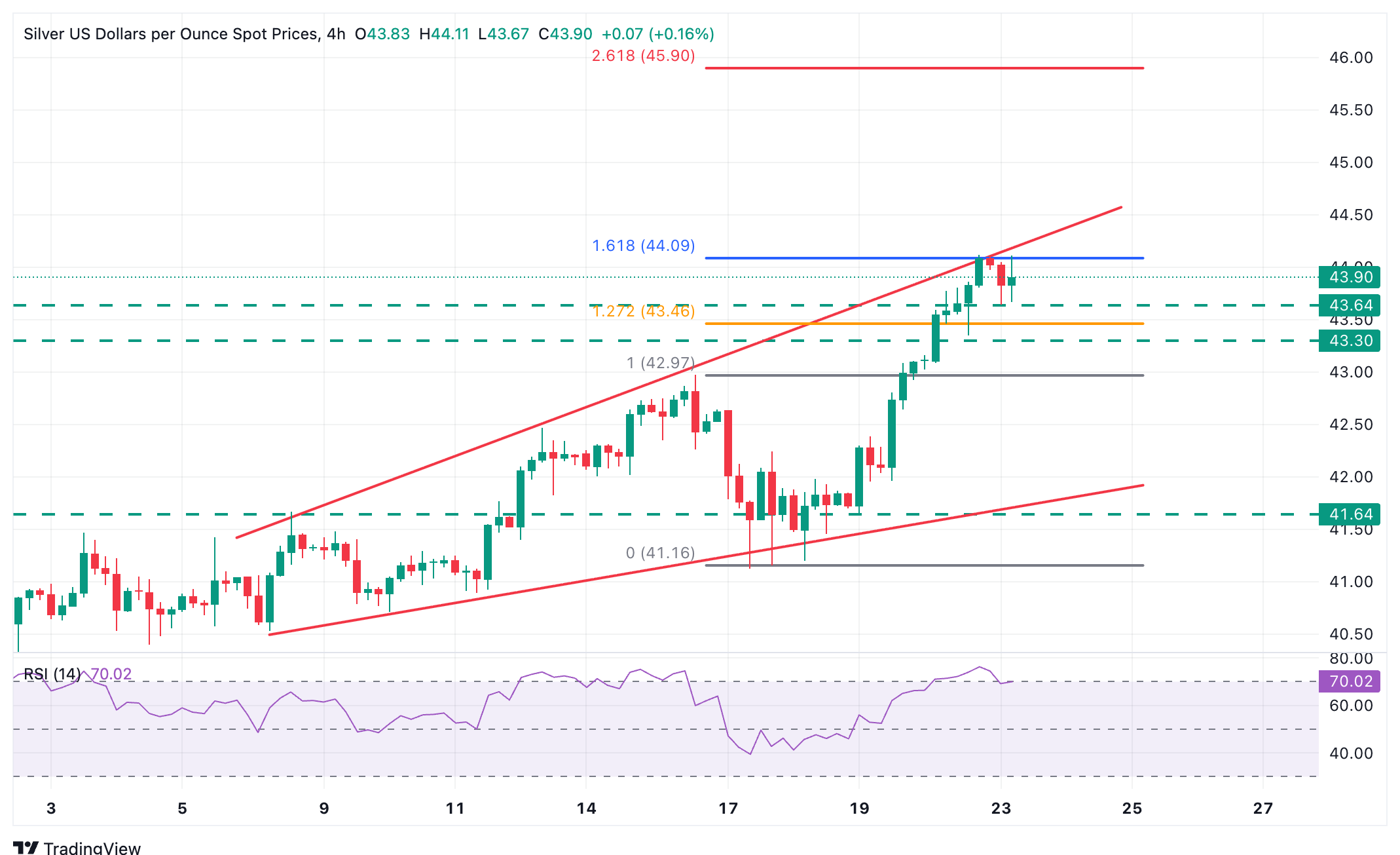Silver Price Forecast: XAG/USD on retreat from $44,10, finds support at $43.65
- Silver bears are struggling to break $43.65 after rejection from long-term highs, at $44.10.
- The US Dollar's recovery is lacking momentum with investors pricing in further Fed rate cuts.
- XAG/USD has pulled back from oversold levels but maintains its bearish trend intact.
Silver’s (XAG/USD) has been consolidating gains for most of Tuesday’s Asian session, as the precious metal’s retreat from all-time highs at $44.20 has been contained above the $43.65 area, and is trading near $43.90 on the Early European session.
The XAG/USD pair’s reversal has lost momentum on Tuesday’s early trading as the US Dollar’s recovery is lacking follow-through so far. Fed speakers offered mixed views about the path of the Fed’s monetary policy, which failed to alter the view that the US central bank will be forced to cut rates further in the coming months, to support a deteriorating labour market.
Markets, however, are likely to be little moved during the European trading times, with investors awaiting the release of US Flash PMIs to assess the impact of tariffs on business activity and Fed Powell’s speech about the Economic Outlook.
Technical Analysis: Holding gains with the bullish bias intact

From a technical perspective, the pair maintains its broader bullish bias intact. The correction from Monday’s highs has pulled the 4-hour Relative Strength Index back below overbought levels but still well above the 50 line, which reflects positive momentum.
To the downside, below the mentioned intra-day low, at $43.65, Monday’s low, at $43.35, might provide some support ahead of the previous peak, at the $43.00 area (September 16 high.
To the upside, there is a trendline resistance in the $44.10 area, ahead of the $45.00 psychological level and the 261.8% Fibonacci retracement of the mid-September pullback, at $45.90.
Silver FAQs
Silver is a precious metal highly traded among investors. It has been historically used as a store of value and a medium of exchange. Although less popular than Gold, traders may turn to Silver to diversify their investment portfolio, for its intrinsic value or as a potential hedge during high-inflation periods. Investors can buy physical Silver, in coins or in bars, or trade it through vehicles such as Exchange Traded Funds, which track its price on international markets.
Silver prices can move due to a wide range of factors. Geopolitical instability or fears of a deep recession can make Silver price escalate due to its safe-haven status, although to a lesser extent than Gold's. As a yieldless asset, Silver tends to rise with lower interest rates. Its moves also depend on how the US Dollar (USD) behaves as the asset is priced in dollars (XAG/USD). A strong Dollar tends to keep the price of Silver at bay, whereas a weaker Dollar is likely to propel prices up. Other factors such as investment demand, mining supply – Silver is much more abundant than Gold – and recycling rates can also affect prices.
Silver is widely used in industry, particularly in sectors such as electronics or solar energy, as it has one of the highest electric conductivity of all metals – more than Copper and Gold. A surge in demand can increase prices, while a decline tends to lower them. Dynamics in the US, Chinese and Indian economies can also contribute to price swings: for the US and particularly China, their big industrial sectors use Silver in various processes; in India, consumers’ demand for the precious metal for jewellery also plays a key role in setting prices.
Silver prices tend to follow Gold's moves. When Gold prices rise, Silver typically follows suit, as their status as safe-haven assets is similar. The Gold/Silver ratio, which shows the number of ounces of Silver needed to equal the value of one ounce of Gold, may help to determine the relative valuation between both metals. Some investors may consider a high ratio as an indicator that Silver is undervalued, or Gold is overvalued. On the contrary, a low ratio might suggest that Gold is undervalued relative to Silver.

